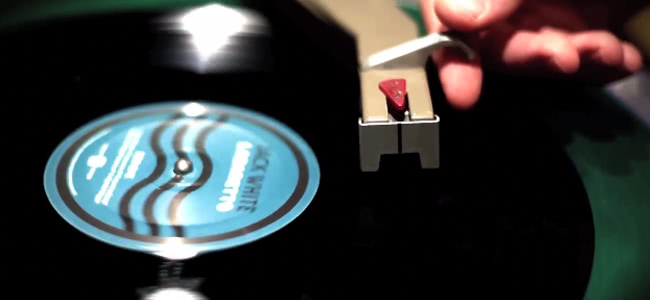There’s no denying the mass resurgence of vinyl in recent years, and from a sales perspective, the signs are everywhere: the year-on-year success of the annual Record Store Day, LP figures in Australia doubled in 2013 while Stateside, the US is enjoying a 40% increase on vinyl sales from this time last year, reaching a record 6.1 million units.
Then there’s the unofficial poster boy for the vintage format, Jack White, whose trick-laden Lazaretto ‘Ultra LP‘ is not only the best selling slice o’ wax in 2014 but smashed a 20 year old record for the biggest first-week vinyl sales.
But for all the positive momentum to be found in vinyl getting a second spin worldwide as demand exponentially increases, the wider context provides a negative flipside – the proverbial Side B – of the LP’s market growth.
For instance, despite the increased demand for vinyl the number of pressing plants is seemingly fixed, with no new or large scale record-producing operations on the horizon, while research demonstrates that a worrying proportion of people who are buying records aren’t even listening to them.
[include_post id=”409018″]
That’s two key takeaways from Pitchfork‘s newest cover story ‘Wax And Wane’, which seeks to further analyse the ‘Tough Realities Behind Vinyl’s Comeback’ – as its subtitle reads.
Early on in the in-depth piece, representatives from indie labels such as Ashtmatic Kitty, Secretly Canadian, Jagjaguwar, and Dead Oceans lament the limited number of pressing plants in America available to the music industry – a number that shows no imminent sign of growing – that are faced with pumping out ever-larger amounts of records to meet the buying US public’s rapidly growing appetite.
Love The Beatles?
Get the latest The Beatles news, features, updates and giveaways straight to your inbox Learn more
An increasing demand that the “dozen or so” operative plants are struggling to meet, causing delays in production and shipping. “You used to be able to turn over a record in four weeks,” Asthmatic Kitty’s John Beeler tells Pitchfork. “But I’m now telling my artists that we need at least three months from the time they turn it in to the time we get it back.”
Nick Blandford, managing director of the Secretly Label Group, adds that production lead times have “been longer this year than they were even nine months ago … We crossed our fingers and hoped that turn times would improve after Record Store Day in April, but they’re still about the same. We’ve just accepted this as the reality.”
[include_post id=”411012”]
The latent concern shared by vinyl-makers is that this sluggish rate of production will only rise in correlation to demand, forcing them to make promises they can’t keep or that an already fickle music-purchasing public will start looking elsewhere for their fix if forced to wait months on end for pre-orders.
That’s even assuming that those buying up all vinyl are even putting the record to platter. According to a study by London’s ICM Research, “15% of those who buy physical music formats such as CDs, vinyl records, and cassettes never listen to them – they buy them purely to own.”
ICM, who revealed their figures in the wake of this year’s storming Record Store Day, states that “this behaviour is driven by 18-24 year old music purchasers, with just over one quarter (26%) buying music to own not play.” More significant given that the 18-24 age bracket continue to be the biggest driver for growth – even if it’s purely to showcase their vinyl library as a matter of taste and status, rather than a sonic archive they regularly re-visit.
It was a similar portrait painted by a casual study made last year that showed that while vinyl sales were on the up and up – they weren’t being matched by growing sales of record turntables and needles in order to play them.
[include_post id=”327196″]
What might account for the gulf in this glaring correlation is that the Generation X scooping up vinyl might be doing so for the digital download cards that come with new releases, as ‘Wax And Wane’ points out.
So whether a record is ending up as a cultural trophy for “showing off what your tastes are as a way of defining what’s important to you,” as the co-owner of California’s legendary Amoeba Music puts it to Pitchfork, or is actually filing the ears of the audiophile-loving fans who are spinning them on their high-end systems – both are contributing to the vinyl sales boom either way.
But the most worrying aspect of the vinyl resurgence is that for all its gathering momentum, it’s still a drop in the ocean when placed in the larger context of album sales as a whole – which at this point in history are at their lowest ever.
To illustrate, America’s best-selling vinyl album of the year – the 49,100 copies of Jack White’s Lazaretto – would have to shift that amount another 55 times over to reach the staggering numbers of the top-selling US album of 2014 so far: Disney’s Frozen soundtrack and its 2.7 million copies across all formats. Hypothetically, even if all 12 of the US’s pressing plants were working around the clock solely on pumping out White’s ‘Ultra LP’ it couldn’t hope to compete.
The silver lining? As Pitchfork’s exhaustive piece summaries: “despite the growing pains that come with high demand and fixed production, the resurgence is still surging.”
Top 10 Selling Vinyl Albums Of 2014 So Far:
01. Jack White – Lazaretto (49,100 units)
02. Arctic Monkeys – AM (25,100 units)
03. Beck – Morning Phase (21,300 units)
04. The Black Keys – Turn Blue (21,000 units)
05. Lana Del Rey – Ultraviolence (16,500 units)
06. Bob Marley & The Wailers – Legend (13,000 units)
07. The Beatles – Abbey Road (12,600 units)
08. Lorde – Pure Heroine (12,400 units)
09. Mac DeMarco – Salad Days (11,900 units)
10. St. Vincent – St. Vincent (11,400 units)




































